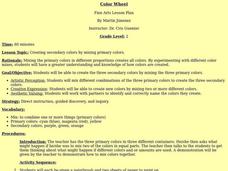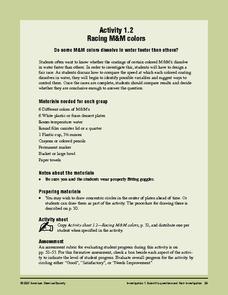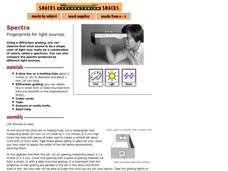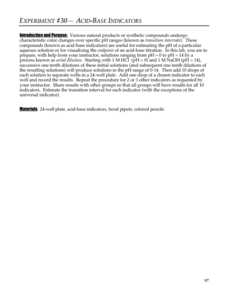Curated OER
The Gift of Life - Day 2: "Cell & Organelle Time to Tell" and "World in Color" (Chapters 2-4)
Students complete a cell biology lesson and a color lesson based on The Giver. In this biology and reading comprehension lesson set, students examine cells using microscopes. They look at the organelles and listen to How Much is a...
American Chemical Society
pH and Color Change
Did you know strong bases can feel slippery and slimy? Lesson allows scholars to practice using the pH scale to identify acids and bases and their strengths. By changing the concentration of an acid and a base, they create the entire...
Baylor College
Why Circulate?
Lub-dub, lub-dub. Why does the heart beat? Why does blood circulate throughout the body? Life scientists find out how important circulation is for dissolving and dispersing materials by timing how long it takes for food coloring spread...
Curated OER
The Effect of Natural Selection on Genes, Traits and Individuals
Rotating through five stations, evolutionary biologists explore the question of how changes in DNA facilitate the changes in a population over time. High-quality, colorful cards of animals, skeletons, skulls, and DNA sequences can all be...
Curated OER
Partitioning a Hexagon
The task at hand is to partition a hexagon into two, four, and eight congruent figures. Make sure to give your wizards a sheet of triangle grid paper on which to decompose the hexagons. Have them explain which rotations, reflections, or...
Texas State Energy Conservation Office
Investigation: Making a PV Cell
Rise and shine! Class members collaborate to construct a photovoltaic solar cell with two semiconductor layers, as guided by this fabulous lab sheet. They test its output with an ammeter or galvanometer.
Curated OER
Color Wheel
Second graders mix different combinations of the three primary colors to create the three secondary colors, then create new colors by mixing two or more different colors. They identify the colors they create.
Curated OER
Autumn Math
For this fall counting and coloring worksheet, students practice their math skills as they count the number of leaves in the fall scene that may be colored.
Curated OER
Half Note: Print and Color
In this word recognition worksheet, students trace the word "half note", write the word independently, and color the picture of the half note.
Curated OER
Treble Clef: Print and Color
In this word recognition learning exercise, students trace the words "treble clef", write the words independently, and color the picture of the treble clef.
Curated OER
Whole Note: Print adn Color
In this word recognition activity, students trace the words "whole note", write the words independently, and color the picture of the whole note.
Curated OER
Clothing Color Wheel
Students are introduced to the primary, secondary and tertiary colors. Individually, they place the colors into the correct sequence and create their own color wheel. To end the lesson, they share their color wheel with the class and...
Curated OER
Creative Color Wheel
For this color theory worksheet, students draw a large circle on a piece of paper and make six shapes evenly spaced around the circle. Students color the wheel according to the directions. This worksheet is geared toward adults who will...
Exploratorium
Give and Take
Heat-sensitive liquid crystal sheets are available in a variety of sizes and temperature ranges. Purchase a class set of hand-held sheets and color half of each with a silver permanent marking pen. Learners of light can hold them under a...
American Chemical Society
Investigating the Line
Note that this lesson is best paired with the preceding lesson in the unit. In that lesson, elementary physical scientists observed that the color coating of M&Ms® candies do not mix when dissolved off of the chocolate surface. Now...
American Chemical Society
Racing M&M Colors
More than anything, this is great practice in scientific inquiry. After discovering that the color coating of an M&M® dissolves in water during a preceding activity, investigators now question whether or not the color makes a...
American Chemical Society
Neutralizing Acids and Bases
Now that your science class has experimented with pH indicator and identified acids and bases, they attempt to get the cabbage juice indicator back to its original color. This is done through neutralization of the acids and bases that...
Curriculum Corner
Ice Cream Booklet
On the days leading up to summer, use a booklet of practice skill sheets in the classroom. Beginner pupils should be able to master the skills they've learned in math and reading before they head home for the summer, like counting to 30,...
Thoughtful Learning
Checking the Emotion Thermometer
A hand-drawn thermometer provides a strong visual for how much of an emotion a child is feeling. Scholars color the thermometer's mercury to showcase whether what they are feeling is high or low at a certain moment. Questions allow...
Exploratorium
Spectra
Make a class set of spectrum tubes by first purchasing some diffraction grating, and then constructing the tools with mailing tubes or shoe boxes. If you aren't up for assembling them, you could purchase prepared spectroscope kits. This...
Project Oceanography
Fish Shape
A fish's size, fins, and shape can tell us a lot about them! Learners explore fish anatomy to see how species use camouflage, scales, shape, and coloration to survive. The lesson includes advanced vocabulary such as fusiform shape,...
Twisty Noodle
My Book of Rodents
Squeak squeak! A four-page mini book shows learners some examples of rodents. After a lesson about mice, rats, and squirrels, have your class color these pages and publish their own rodent books.
Pingry School
Acid-Base Indicators
Acid-base indicators are an essential part of any chemistry classroom. Individuals explore the color-changing feature of the important indicators in a vibrant hands-on activity. Using serial dilution, learners create solutions ranging...
Curated OER
Earth's Water
If the majority of our planet is covered with water, why do we need to bother conserving it? With a thorough and varied investigation into the location and types of water on the earth, learners will gain an understanding of why this...
Other popular searches
- Christmas Coloring Sheets
- Firefighters Coloring Sheets
- Math Coloring Sheets
- Anti Smoking Coloring Sheets
- Spring Coloring Sheets
- Equal Rights Coloring Sheets
- Polar Bear Coloring Sheets
- Flute Coloring Sheets
- Gold Rush Coloring Sheets
- Haiti Coloring Sheets
- Fathers Day Coloring Sheets
- Thanksgiving Coloring Sheets

























